Predictions on the future of risk management
How risk managers can adjust for the new normal
While you have settled into a temporary state of normal during the pandemic ─ adjusting to disrupted risk evaluations, revising mitigation plans, and embracing new forms of communication ─ you still need to plan how to adjust for the future normal in risk management. We made a few predictions on what the ‘next normal’ will mean for risk management strategies based on learnings from this pandemic experience and our expectations of how the business community should react for better performance long-term. We posed these predictions to two subject matter experts in risk management to see whether their opinions align with our thinking.
Watch the full discussion on the future of risk management on-demand.

Brian Hill
Senior Vice President
Cameron Mutual Insurance Company
Prediction 1
We will all think globally
Whether or not your business is global, you’ll be paying attention to international events. If this pandemic has taught us anything, it’s that far-reaching lands, people and activities hit close to home in ways we never expected.
As risk managers, when it comes to identifying risks we tend to stay geared in what our own specific organizations are doing and don’t often enough look up and out for potential risks outside our known landscape. This prediction is not limited to just geography. Risk managers should also be looking at other industries to identify risk factors that can ripple through relationships in your business and fire up the law of unintended consequences before we can effectively impose risk mitigation plans.
We asked attendees in our live risk management discussion how their thinking changed during the pandemic. 50% responded to say they have taken on a more global view, 36% started exploring alternative risk-sharing strategies, 18% are now utilizing new risk methodologies (e.g. ISO 31000), and 20% said their thinking remains the same.
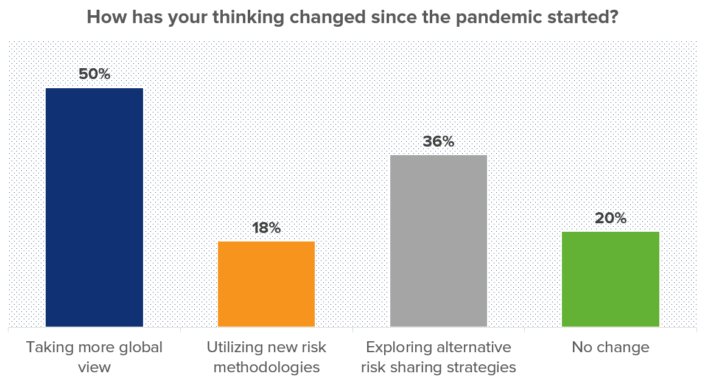
Actions Advised:
- Understand the breadth and depth of your supply chain to proactively plan for potential hiccups in the future.
- Pinpoint potential weak spots in your organization that could benefit from long-term, larger risk management planning.
Prediction 2
Understanding interconnected risks becomes priority
As owners of the risk management process, each of us is responsible for understanding how types of risk could implicate the other side of the business through a dotted line. Making these transparent connections, analyzing the risk, and making contingency plans becomes the most important skill set risk managers can have to succeed in the future.
Positive or negative risks cannot be managed as individual or standalone items, and as such, must be seen as part of a broader connection of items in the overall risk assessment. Your challenge is to be creative about how you establish and evaluate these interrelationships to better identify levels of risk.
Think about how you use your risk register to serve as not just an aggregator, but a connector of risk records. Moving forward, we’ll predict controls becoming more pervasive throughout businesses and captured across broader ranges. As a leader, start to develop the skillsets of your project teams to amplify their analysis and data modeling capabilities.
We asked our live discussion attendees, “As a result of the pandemic, how are you enhancing your ability to connect organizational risks?” 41% responded to say they’re adding technology to improve their risk program, 26% are adding training for employees, 23% are making no changes, 15% are using unmentioned alternatives, and 13% are exploring smart devices.
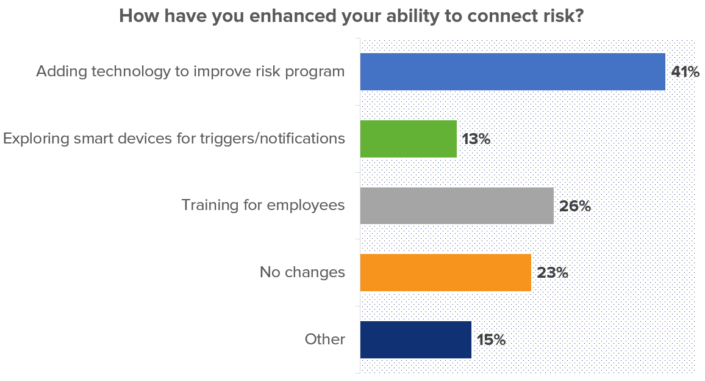
Actions Advised:
- Explore technologies that can automatically connect your risk records.
- Look at alternative technologies like smart devices and sensors to trigger the communication of risks.
- Enable your team with training that elevates your risk management program.
Prediction 3
Risk tolerance will foster a culture of innovation
Because we will all be forced to think nimbly moving forward, our appetite to innovate and curate new ideas will grow to reduce and prevent risks. This type of thinking will be what propels some businesses further and starts all new businesses.
The weaknesses of business’ risk analyses have become noticeable because of this pandemic. The silver lining is that this increased visibility enables us to think more openly about financial, operational, and cyber risks, the gaps that need to be filled and identify cost-effective opportunities that help us problem-solve in ways we would have never done before. Use this time to figure out what you should be doing next and how it should be prioritized within your current list of initiatives.
We asked live discussion attendees about the steps they are taking to improve their current risk management approach. 50% are now evaluating areas of their business previously un-reviewed, 47% are addressing weak elements of their business that surfaced from the pandemic, 20% are shifting from risk identification to mitigation, and 10% haven’t changed their thinking or approach at all. We’re assuming the latter already had strong risk management and business continuity and disaster recovery (BC/DR) plans in place.
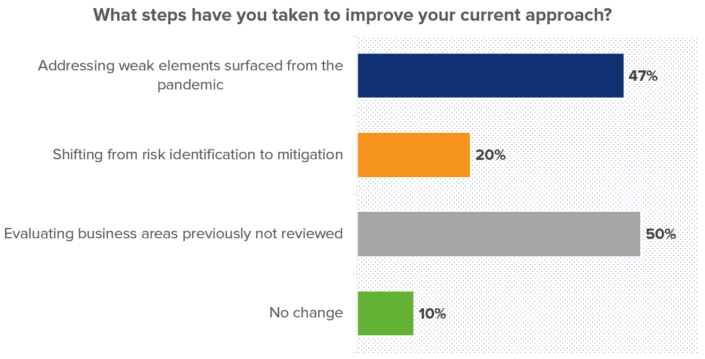
Actions Advised:
- Start thinking about the unthinkable and make a list of everything that comes to mind.
- Use that same list to create new ideas (however grandiose or minuscule) that could solve, prevent, or mitigate unthinkable occurrences.
- Stop thinking at 10,000 ft. and focus on scenario-based risk analyses.
Prediction 4
Technology will demonstrate quantifiable risk management value
The data collection, relationship mapping, and reporting capabilities of risk management software providers today are advanced enough to provide risk management teams the power to measure their contributions to the business.
If you have not started already, begin researching the analytics tools that collect data records on financial values associated with mitigated risks. As project managers become more comfortable with their data analytics skills and understand more of the interconnectedness of risks across other business units, they’ll start accounting for risk management’s added financial value to KPIs.
We asked live discussion attendees which technologies their organization is currently using or plans to use as a result of the pandemic’s impact. 59% responded with a central risk management system, 24% said data analytics platform, 14% are using or planning for automated processing / robotic process automation (RPA), and 10% stated other and did not clarify the details.
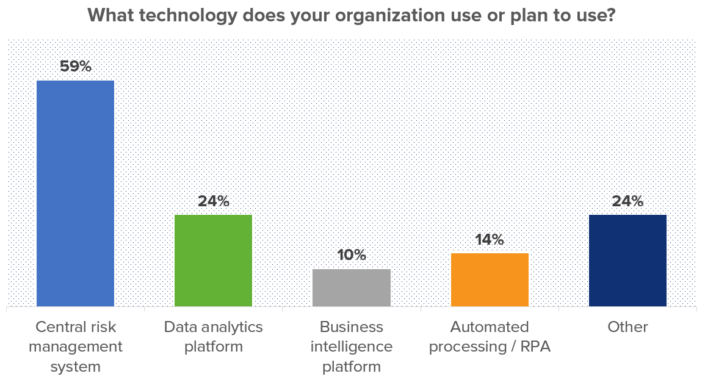
Actions Advised:
- Research and evaluate GRC software platforms that provide reporting capabilities specific to your KPIs.
- List all data records tied to your current KPIs then map how they correlate to overall financial value back to the business.
Prediction 5
Technology will demonstrate quantifiable risk management value
What this pandemic has taught many of us is that the ability to adapt and change is not as scary as we always imagined. We never imagined an entire workforce producing quality work solely from their homes, but it’s happening now and it’s working.
While this has been an educational experience for leadership and wholly welcomed by some, we still predict senior management will bring the workforce back into physical office space. Why? Despite two months of virtual working, leaders still believe face-to-face time doesn’t replace video calls, texts, instant messages and so on.
In the last poll of our live discussion, we asked attendees of their return-to-work plans once stay-at-home orders are lifted in their area. 50% responded to say they’ll rotate between office and home, 24% don’t know yet what they’ll do, 21% will continue working from home full-time, and 6% will go back to the office full-time.
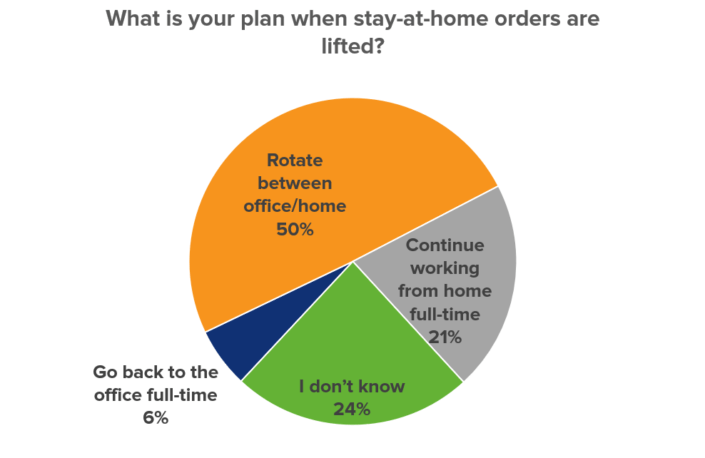
Actions Advised:
- Learn from your extended working from home experience to understand how, where, and when you work best.
- Adjust your future work schedule and location to accommodate by communicating to your organization how you can best support the business.
We presume more than half of these predictions will pan out after many of us return to a new normal post-pandemic. We also anticipate a few surprises to come out of these predictions based on how the economy recovers and how businesses look to protect employees in more ways than one moving forward.
About the author
Jason Rohlf
Vice President at Onspring
20 years Internal Audit & GRC experience







